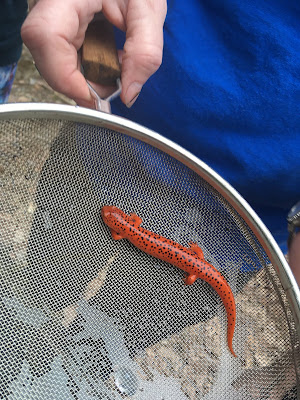 |
| Alligator mississippinesis relaxing in the water last Tuesday |
This past Saturday I made a goal to find a herp I could catch during our walk. We probably walked a mile or so near the ponds and through the woods. I had my husband flip a few logs, I searched for turtles near the water, and NOTHING to be found. We did hear lots of bullfrogs and green tree frogs though. So anyways, we headed back home around 8:00 pm as the sun had almost disappeared. We were about to turn the corner to our street and all of the sudden I see something hop from the edge of the road onto a small pile of leaves in a neighbors yard. I got way too excited, hollered for my husband to hold my phone with the flashlight on and caught an Anaxyrus terrestris (Southern toad). In determining between our local toads, our field guide points out the differences in cranial crests of each particular species. Southern toads, like the one caught can be identified by the high cranial crests with pronounced knobs. Additionally, southern toads often have 1-2 warts in the dark spots on their backs as seen here. You can also see the presence of a light mid-dorsal line on this particular toad. The Southern toad has a bi-phasic life cycle consisting of a larval stage followed by metamorphosis into an adult stage. In case anyone was wondering, my five year old named him Toady and he was happy to be let go after I played paparazzi for a few minutes.

In addition to our evening walks, we have also been doing lots of yard work..sounds fun, right?
Yesterday around 2:30 pm I was bringing one of our trashcans from the backyard to the curb and underneath was this little guy scurrying AS FAST AS CAN BE. That's emphasized because it was SO HARD to catch this little thing. Not only was he super fast, but he would hide under the leaves and because he was tiny (probably 3 inches long) and brown, it was extremely easy to lose track of him in the leaves. But alas, I got him! I identified this species as Scincella lateralis (little ground skink). It was identifiable by its dark dorsolateral stripes on either side of his body and yellowish belly. Their habitats are often leaf litter in woodlands, or under debris in towns and gardens.An interesting fact about this species is that it has a transparent disk in the lower eyelid allowing it to still see when it's eyes are closed! Female Scincella lateralis lay eggs with a clutch size of 1-5 eggs. Throughout this I referred to it as a "him", however the gender of this particular skink was not something I identified. Bella (my daughter) couldn't come up with a name, so I named him George.
 |
| Found him under this black trashcan in my backyard |

































